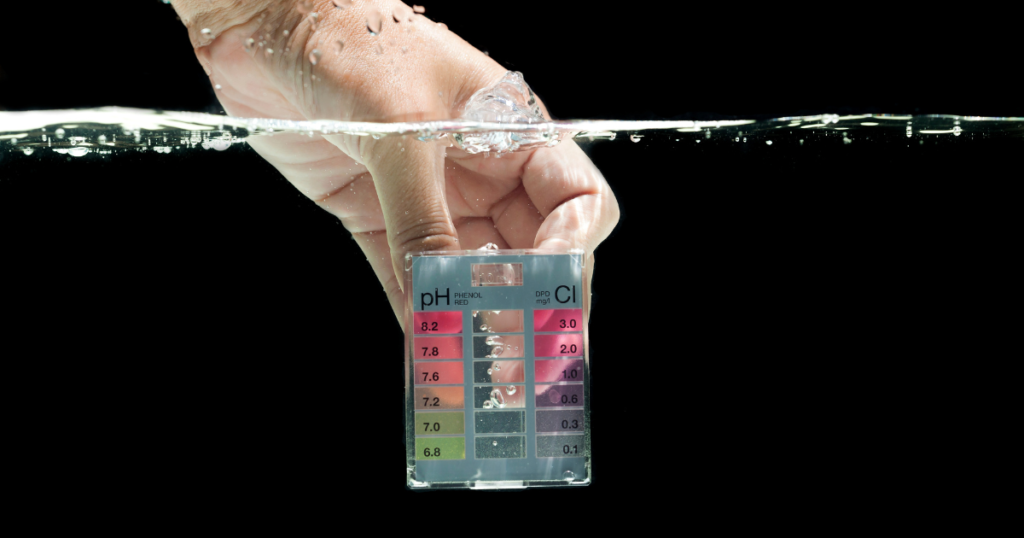Regular pool water testing is essential to maintain a functional and safe pool. Accurate readings for the different parameters of pool water chemistry play an important role in scheduling maintenance, along with other benefits such as saving you time and money.
Out of the various methods available, here we will learn the essentials of using a pool test kit.
Why is regular testing essential?
Pool water can quickly deteriorate without regular maintenance, even with minimal usage. Ignoring your pool's water balance can result in minor inconveniences, or it may result in an expensive mistake.
Here are a few good reasons to conduct regular testing of your pool water:
- An imbalance in the alkalinity and pH levels can be hazardous for your health and pool. A low pH (acidic) can cause skin irritation and damage pool walls, equipment, and accessories. Similarly, a high pH can result in cloudy pool water and scaling on the pool sides.
- An outbreak of algae or white water mold will be detrimental to the aesthetics and your pool equipment.
- Avoiding regular checks on total calcium hardness can cause damage to the pool.
What different types of pool test kits exist?
The two most common types of pool test kits are—DPD test kits and OTO-Phenol test kits. Their names tell us about the methods used to measure different parameters.
In simple terms, an OTO test kit measures the chlorine and pH of the pool water. A basic DPD kit measures pH, free chlorine, total alkalinity, stabilizer, and hardness.
Other variants measure a few extra parameters and can work for non-chlorine pools. Additionally, there are kits specially made for testing parameters in a saltwater pool.
Pool test kits also come in a variety of options for evaluation parameters. There are two-in-one kits that measure only the pH and chlorine.
Then there are four, five, and six-in-one kits that measure even more of these parameters. Plus, some kits have extra tablets, chemicals, or strips for testing other uncommon parameters.
What can you measure with a test kit?
Depending upon the type of pool test kit, you can measure between two and seven water chemistry parameters. Let's look at them and also their recommended frequency of testing:
- pH Levels: check twice or thrice each week
- Total Alkalinity: once a week, or unless the pH has changed
- Free Chlorine: Twice or thrice a week.
- Total Calcium Hardness: Once a month
- Cyanuric Acid: Once a month
- Total Dissolved Solids (TDS): Once a month
- Total Bromine: Twice or thrice a week

How to use a test kit
Before using a pool test kit, it is essential to look at and understand the user manual. It will correlate the bottles (containing reagents) with their respective parameters. The naming of these reagents differs from brand to brand.
So get yourself familiar with each reagent and its purpose. Now let's look at the steps to use these:
- Rinse the testing tubes/vials and make sure they are clean
- Dip these vials about 18 inches or forearm length inside your pool water and scoop up a water sample.
- Make sure the vials contain the recommended levels of water for testing. It is usually a line near the top end of the vial.
- Follow the directions in the manual. Drop the recommended amount (measured in drops) of reagent in the vials for a specific test.
- Shake the vials and allow the reagent to settle for the recommended duration
- Match the final color of the water inside the vials with the color-coded strip using the instruction manual. Do this for all the parameters you want to measure.
- Once you are done testing the water, wash the kit and store it properly.
What are the optimal water chemistry levels?
These are the desired levels for different parameters of the water chemistry in a pool:
- pH Levels: 7.2 to 7.8
- Total Alkalinity: 80-120 ppm (parts per million)
- Free Chlorine: 1-3 ppm
- Total Calcium Hardness: 200-400 ppm
- Cyanuric Acid: 30-50 ppm
- Total Dissolved Solids (TDS): Under 2,500 ppm (for non-saltwater pools)
- Total Bromine: 3-5 ppm
The top Tips for using a pool kit
Using a pool testing kit should be easy if you follow the instructions in the manual. However, there are also a few tips that will make things easier:
- Use a fresh water sample whenever testing for multiple parameters.
- Record the pool water chemistry data every time you test. It will be helpful when professional pool services need previous pool data.
- Do not mix reagents from different testing kits.
- Do not use expired testing kits. They typically last for about a year.
What else can you do to test your pool water?
Apart from testing kits, you can use pool test strips or a digital water monitor or take the sample to your local pool water testing laboratory.
Pool test strips
Pool test strips are similar to testing kits, except that they are easier to use and cost less. A test strip can measure between four and seven water chemistry parameters, which takes only 15-20 seconds. Although it is a quick and easy method, pool test kits are significantly more accurate.
Pool water Monitor
A pool water monitor is a carefree and accurate device that usually sends updates on an app. For instance, our Sutro Pool Water Monitor is a battery-powered device that can stay submerged inside your pool water. It relays real-time updates of the water chemistry parameters directly to a mobile app. It not only helps with quick updates, but you can also keep track of your water balance anywhere and anytime.
Conclusion
A pool testing kit comprises several chemicals (called reagents) to be mixed with water samples to evaluate the water chemistry. Although, it takes some time and effort compared to pool strips and digital monitors. Testing kits are very accurate and cost-effective.

